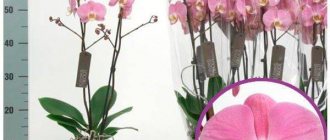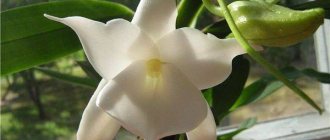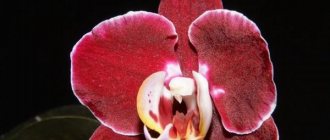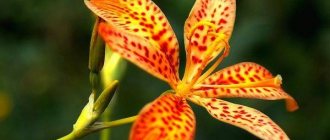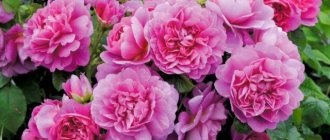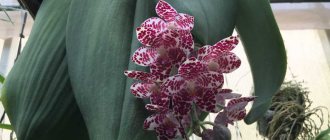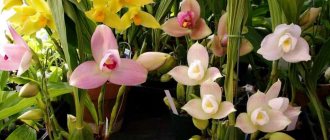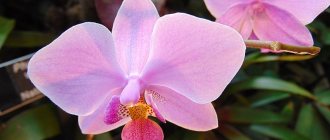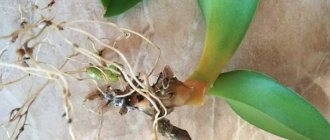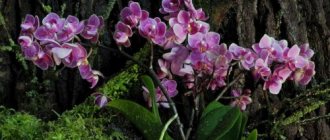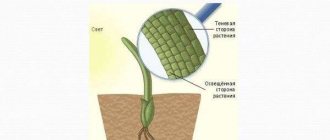Among the beautiful “butterflies” - exclusive orchids there are representatives are completely different in appearance.
Some varieties of this plant are unpretentious and do not require close attention. Others, on the contrary, are so capricious that it is better for novice gardeners not to deal with them. Knowledge about the characteristics of orchids is necessary to provide comfortable conditions for the plant and ensure its continued flowering. Find out what features of orchid varieties have: Lycasta, Lelia, Liparis, Leerdam.
Lycasta
The low Lycaste orchid produces a peduncle from the base of the bulb; its length can reach 25 cm, depending on the variety. Cultivated species have brighter and larger flowers than their wild ancestors. The diameter of the flower reaches 15 centimeters.
Lycastus Orchid.
There is one waxy “butterfly” on the peduncle, rarely two, endowed with a subtle pleasant aroma. Sepals and petals often differ in color. The petals point upward in an arch above the lip. Lycasta has folded, dense leaves; the bulbs are oval or pear-shaped.
The plant's homeland is the tropical zone of South America. The distribution area of Lacasta depends on natural conditions. Preferring fresh air and high mountain areas, the flower can grow in Guatemala, where it is revered as national and is called the “White Nun”. The fragrant Licasta variety is common in Mexico.
Orchid colors can be different: white, orange and pink. But the main color of this variety is yellow.
Features of the flowering of this variety of orchids are the presence of many peduncles that produce flowers almost simultaneously.
The duration of flowering of “butterflies” can last up to a month ; that is how long they can delight flower growers with their beautiful appearance.
The dormant period at home begins in the fall , it can be determined by the falling of yellowed leaves. At this time, watering stops for fourteen days. We keep the container with the flower in a bright room with a temperature of about 12 degrees.
Important! We pay attention to the condition of the bulbs and do not allow them to dry out.
Types of Lycaste orchids:
- Skinner It is considered the most beautiful orchid of this genus. Flowers of a white-pink hue, with a diameter of 15 cm, bloom on peduncles up to 35 cm. On the three-lobed white lip, lines and specks of a violet-red hue, its base is dark purple. This splendor is suitable for cutting into beautiful bouquets;
Skinner. - Fragrant or fragrant emits a strong and pleasant odor. The flowers are painted in various shades, but mostly green, yellow and brown. Peduncles of single “butterflies” grow up to 20 cm;
Fragrant. - Bloody - it would seem that the color of her flowers should be red, but Wikipedia did not confirm this - it is the same yellow, just a little closer to orange. You can find the photo below. Spotted sponges are colored in light or completely white shades.
Bloody.
Watch a video about the features of caring for Lycasta after purchase:
Botanical description
The genus Lycaste (lat. Lycaste) (see photo) includes about 50 species of orchids with a sympodial type of branching. This means that the growth of the top of the main axis eventually stops and gives way to a lateral branch, which grows in the direction of the same axis.
A characteristic feature of this genus is the shedding of leaves after a natural period of rest.
The natural habitat of lycastes is the tropical rainforests of the mountains and plains in Central and South America, which stretch from Mexico to Peru.
The genus of Lycaste orchids, in addition to the natural species, also has a certain number of hybrids. They are characterized by large and very bright flowers.
Lycastes belong to the group of epiphytic or terrestrial plants. Their growth is favorably influenced by moderate and warm temperature conditions. Their pseudobulbs are thick and the leaves are thin, folded and large, which fall off at the end of the season.
Liparis
Liparis are ethereal plants , that is, they can live not in a substrate, but on a simple block, which can be a tree, a piece of bark or a stone.
The orchid genus Liparis got its name from the Greek word for “fat” because of the shine of its wide, large and squat leaves. The plant may have several ovoid tubers, which, like the base of the stem, are “dressed” with leaves.
The plants reach a height of about 20 cm. On the winged-ribbed peduncle there is an inflorescence called a raceme.
The flower, whose diameter is up to 2 cm, consists of:
- lanceolate sepals, which may have “ears”;
- linear petals;
- an ovoid lip directed downwards towards the base, becoming already having waves along the edges.
The ovaries of the flowers are club-shaped with twisted pedicels.
Liparis is an orchid that naturally grows in tropical zones and has up to 300 species. There are varieties growing in Russia. Six species of Liparis orchid are grown in cultivation.
The following colors of the Liparis orchid are found:
- the brightest and largest in diameter “butterflies” are those of the Kumokri ; they can even have a reddish tint;
- bright pinkish flowers in the lily-leaved variety ;
- The Sakhalin orchid does not shine with the brightness of its colors, but surprises with the large size of its blossoming buds.
Campylostalix.
Lily-leaved.
Sakhalinsky.
The remaining varieties of Liparis do not differ in the brightness of their colors. They are inconspicuous, yellowish-green in color.
The plant reacts negatively to fluctuations in air temperatures . For Japanese Leparis, this condition, on the contrary, gives impetus to the beginning of flowering.
The flowering time of this variety of orchids is a little more than a month, usually from late spring to mid-summer.
Important! The dormant period at home is winter, when the plant does not need thorough watering, but it needs cooler rooms.
Temperature and lighting
The temperature regime for lycast can be within +24 °C. Lighting for plants should be bright and diffused. They can be placed in the eastern or southern parts of the house, with some shading.
In winter , when the dormant period begins, other conditions are created for the lycastes, which can be read in more detail below.
Read about flowers with yellow flowers with us.
Growing acidanthera requires knowledge of planting and care. Find out more about this.
What care does autumn helenium need? https://sad-doma.net/sadovye-rasteniya/tsvetushhie-sadovye-rasteniya//gelenium/gelenium-osennij-posadka-i-uhod.html We have prepared a detailed answer.
Promenea
The difference between Promenea orchids is their compact size and sympoidal type of growth. The modified stem of the plant, the rhizome, is in a creeping state.
Small pseudobulbs, ovoid and slightly flattened, are located under the petioles of the lower leaves. The upper, petiolate leaves grow from their tips. They reach 10 cm.
The color of the broadly lanceolate leaves is pale green, slightly grayish. Darker veins stand out on them.
Peduncles growing up to 10 cm are located in the leaf axils. Each blooms with up to 2 flowers, the diameter of which reaches 5 cm.
The Promenea orchid flower consists of:
- three sepals - sepals, lanceolate or oval;
- two oppositely located petals - petals, differing from sepals in shape or color;
- three-lobed lip, a modified petal resembling a shoulder blade, the sides of which are bent vertically;
- curved column.
The flower resembles an open “mouth”, fascinating with its shades.
The colors of the orchid are different for each type of plant:
- at Promenaea citrina only a few burgundy spots on the lobes and lip, and the rest is all yellow;
Promenaea citrina. - Promenaea stapelioides It is striking in the presence of different colors: the lips and column are painted with a dark purple hue from the inside, and there are spots of light colors on them along the edges. The yellow petals have uneven burgundy stripes;
Promenaea stapelioides. - In Promenea freckled, small burgundy dots are located on the surface of the irregularly shaped yellow sepals. Almost the entire surface of the flower is strewn with burgundy spots - freckles of various sizes.
Promenea stapelidae.
The peculiarity of flowering is that the plant can, after dropping its flowers, begin to grow young pseudobulbs. And then the orchid does not need a period of rest. Although such frequent situations can weaken the plant. Flowering duration can be from 4 to 8 weeks.
The rest period at home occurs twice a year. The plant needs winter rest after the pseudobulbs have rounded and sprouts have appeared. It is necessary to reduce watering and lower air temperatures. Dormancy ends with the appearance of flower stalks. The second time the orchid goes into “rest” at the end of flowering. It lasts up to 3 weeks.
You will learn everything about the Promenea orchid from the video below:
Pests
Possible attacks by insect pests include attacks by scale insects and, if kept dry, spider mites. Having noticed thin cobwebs on an orchid, you need to immediately sound the alarm and take measures against the mite. The drug Actellik works well against it. A sign that the plant is affected by scale insects should be the appearance of sticky droplets and dark spots on the petioles, leaves and peduncles. In untreated cases, you can get by by washing the specimen with a 20% solution of fragrance-free laundry soap. In case of severe damage, it is necessary to use chemical insecticides.
Lelia
The Lelia orchid got its name from the name of the ancient Greek virgin, the Vestal Virgin, guarding the goddess Vesta, Lelia. The plant belongs to the group of orchids of sympodial growth type; it has creeping stems.
Among the plants of this species there are miniature ones - up to 12 cm in height, and giant ones - up to 1 m . Pseudobulbs of small varieties are oval in shape, while large ones are reed-shaped. Thick leaves feel hard to the touch.
Having a belt-like or elongated oval shape, they are pointed at the ends and slightly folded along the main vein.
A tall peduncle can be “covered with a cover”. Large - up to 10 cm, and sometimes 20 cm, brightly colored flowers are collected in racemes and have a pleasant aroma. The shape of the sepals and petals is slightly pointed, lanceolate. The wavy petals are wider than the belt-shaped sepals. The lip can be solid or three-lobed, and have a smooth or fringed edge. The lip completely hides the column.
Orchid subspecies:
- at Laelia is double-edged at the end of winter, from two to five flowers appear on a peduncle up to 60 cm. Their size is up to 8 cm, colors are light pink or lilac-purple. Ribbed pseudobulbs have an oval-oblong shape, throwing out one or two leaves;
Double-edged. - pseudobulbs Laelia purpurea grow up to 60 cm, throw out one leaf. In spring, the plant blooms with white or pale lilac fragrant flowers, the diameter of which is up to 20 cm. These giant “butterflies” are located on a short peduncle;
Laelia purpurata trilabelo. - Lelia Millera has straight, narrowed pseudobulbs. They look very decorative thanks to the light purple bloom and narrow leaf at the top. In a direct inflorescence there are up to 7 flowers with a diameter of 5 cm, painted purple with an orange-red lip. Blooms for 2.5 weeks in summer.
Miller.
The birthplace of the species is Mexico. The distribution area is in the temperate and subtropical regions of the West Indies and many South American countries.
Orchids come in a wide variety of colors, mainly pink, lilac, lilac and purple shades.
The characteristics and duration of flowering vary among different varieties of this species. The dormant period at home is the autumn-winter period. But more often the plant does not focus on the seasons and begins to rest when a new bulb begins to bloom. The dormant period ends with the release of a peduncle.
Video with personal experience of growing Lelia:
Rules of care
All types of orchids prefer bright places, but without direct sunlight. Sometimes it is necessary to use artificial lighting with fluorescent or phytolamps.
Advice! If the plant has a dormant period, then the air temperature should not exceed 15 degrees. The rest of the time it is possible to reach about 20 degrees.
Watering must be correct:
- moderate, during the rest period;
- be careful not to let water touch young leaves;
- pleasant, for which we use soft, settled water.
It is better to spray with distilled water.
Feeding is carried out during the growing season of the orchid, which often coincides with the beginning of spring.
Stimulation of orchid flowering is carried out by increasing the air temperature, increased watering or spraying under a warm shower. To increase the duration of flowering, you cannot move the container with the plant to another place.
Growing problems
Lycasta is sensitive to excessive watering and substrate salinity; it requires annual replanting.
Liparis feels good on blocks that can replace the substrate.
Liparis is recommended to be grown on a block.
Promenea needs to be transplanted only in an emergency, such as salinity or decomposition of the substrate. She is a fan of coolness , prefers 16–21 degrees in summer, 12–15 C in winter.
Lelia needs to be kept cool to bloom in winter, perhaps about 5 degrees. This orchid is quite capricious and is not recommended for novice orchid keepers , since it requires specific conditions that are as close to natural as possible. Requires bright light to promote the formation of flower buds and the growth of pseudobulbs.
Secrets of success
In nature, Lycasta lives in shady forests, but in cultivation it requires good lighting, especially when flower stalks appear. But the plant must be protected from direct sunlight.
Lycasta loves fresh air. Regular ventilation is designed to satisfy this need. Drafts have a negative impact on the health of the plant.
Ensuring proper temperature conditions is a difficult task. The maximum permissible daily summer temperature is +25°C, the minimum winter temperature is +10°C. At the same time, without a mandatory decrease of 4–10°C at night, the plant suffers.
Licaste needs an average level of humidity. Fine spraying is allowed only around the flower. If drops do fall on the leaves, you need to carefully blot them with a napkin.
Lycasta absolutely does not tolerate the salinity of the substrate. Soft, boiled and filtered water is suitable for irrigation. Both dry and waterlogged soil are equally harmful.
Lycasta needs regular feeding. You can only use special fertilizers for orchids. It is advisable to alternate the usual method of feeding with foliar feeding - spraying with a solution of low concentration.
Main landing features
To attach the plant to a block, for example, on a large piece of bark, we fix the roots on a sphagnum pad.
We select soil in specialized stores. Only an experienced gardener can prepare the substrate on his own. A high-quality substrate should consist of:
- moss that retains moisture;
- fern roots;
- tree bark;
- some flower soil.
For the Promenea and Lelia orchids, either a substrate made of sphagnum and a piece of pine bark, or a block, is suitable.
Advice! You can use wood, bark and even stone as a substrate for the plant.
We take a container for planting special for orchids: transparent and with drainage holes. This provides the plant roots with light and breathability.
The most important thing in planting technology is not to damage the roots. During an orchid transplant you may find:
- rotting roots or parts of the plant that need to be removed by sprinkling the cut with charcoal;
- the presence of pests that need to be eliminated;
- growth of roots to the walls of the pot, which must be freed without damaging.
First steps after purchase
When purchasing Lycasta, you need to inspect all visible parts of the plant. Pests settle on the underside of leaves. Spots on leaf blades indicate improper watering, and changes in color indicate irregularities in lighting. If there are no alarming signs, the flower can be transported into the house. It is necessary to protect it from precipitation, gusts of wind and scorching sun.
There is no need to postpone the transplant. A comfortable pot and a good substrate will provide comfortable conditions for the plant. During the acclimatization period, watering is minimal.
Reproduction methods
Asexual methods of propagation of orchids are carried out:
- dividing rhizomes in spring only in large plants;
- lateral shoots separated from the mother;
- cuttings, using apical shoots of monopodial plants;
- old bulbs, planted in a separate container.
Reproduction by division.
Sexual methods of propagation of orchids include the use of seeds, the germination of which is considered a complex process.
